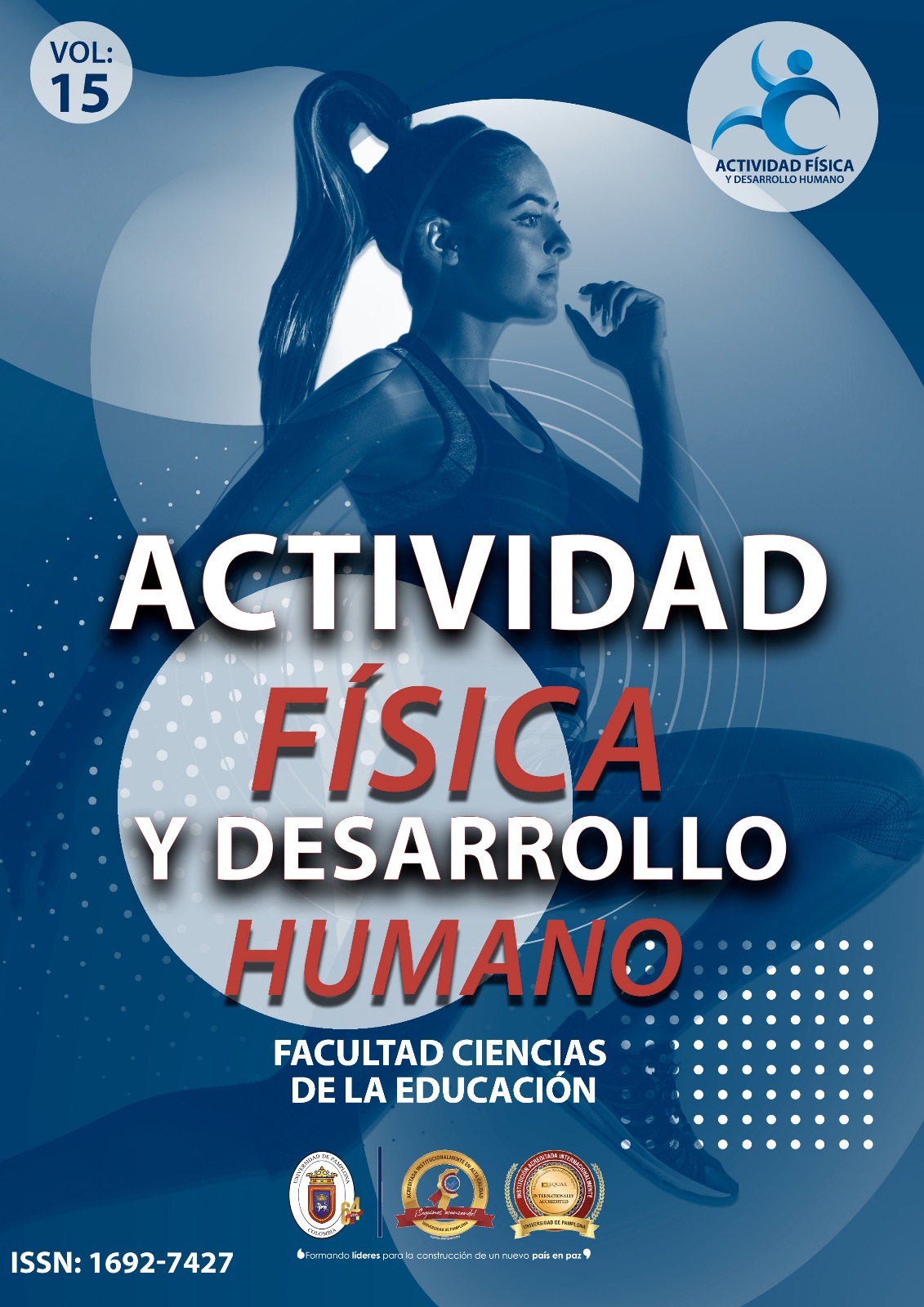Efectos del entrenamiento HIIT en funcionarios de la empresa Almidones de Sucre
DOI:
https://doi.org/10.24054/afdh.v15i1.3137Palabras clave:
HIIT, composición corporal, pandemia COVID 19Resumen
Objetivo evaluar los efectos del entrenamiento de intervalos de alta intensidad (HIIT) en la composición corporal de funcionarios de la empresa Almidones de Sucre durante la pandemia de 2021. Metodología: Estudio de enfoque cuantitativo de tipo correlacional y de corte transversal; Se implementó un programa HIIT de 12 semanas con 30 participantes, evaluando cambios de composición corporal mediante mediciones del % de grasa corporal, peso óseo, peso muscular y peso residual con ISAK I perfil restringido. Se aplicó un pretest y un Postest de la intervención, y se aplicó análisis descriptivos e inferenciales, incluyendo pruebas ANOVA y de correlación de Pearson. Resultados: Los resultados mostraron una reducción significativa en el porcentaje de grasa corporal del 24.2% al 21.4% (p < 0.05) y un aumento en el porcentaje muscular del 40.8% al 43.0% (p < 0.05). No se observó cambios significativos en el peso óseo ni en el residual. Las correlaciones altas entre Pretest y Postest (r > 0.85) indicaron consistencia en los datos. Discusión: Los hallazgos son consistentes con estudios previos que destacan la eficacia del HIIT para mejorar la composición corporal y la salud metabólica. La reducción en del % de grasa corporal y el aumento en el peso muscular sugieren que el HIIT es una estrategia efectiva para mejorar la salud física en un periodo relativamente corto, incluso en el contexto de restricciones por la pandemia. Conclusión: El entrenamiento HIIT se presenta como una intervención eficaz para mejorar la composición corporal de los funcionarios de la empresa Almidones de Sucre, destacándose como una alternativa viable para mantener la salud y el bienestar durante tiempos de pandemia.
Descargas
Referencias
Boyle, M (2016). Entrenamiento Funcional Aplicado a los Deportes. Editorial tutor.
Cigarroa, I., Barriga, R., Michéas, C., Zapata-Lamana, R., Soto, C., y Manukian, T. (2016). Efectos de un programa de ejercicio de fuerza-resistencia muscular en la capacidad funcional, fuerza y calidad de vida de adultos con enfermedad renal crónica en hemodiálisis. Revista médica de Chile, 144(7), 844-852. https://scielo.conicyt.cl/scielo.php?pid=S0034-98872016000700004&script=sci_arttext&tlng=en
Cotacio-Avila, L. F. (2016). Ejercicio físico enfocado en trabajos de fuerza resistencia para mujeres mayores de 45 años en pro del mantenimiento de la aptitud física [Doctoral dissertation, Universidad Nacional de La Plata] https://memoria.fahce.unlp.edu.ar/library?a=d&c=tesis&d=Jte1250.
Lópes, J. y Fernández, A. (2006). Fisiología del ejercicio 3 edición. Editorial medica panamericana.
Sánchez, D. (2018). HIIT Entrenamiento de intervalos de alta intensidad Ponte en forma, pierde grasa y mejora tu salud con solo 20 minutos de entrenamiento, 3 veces a la semana. Profit Editorial I., S.L.
Suárez-Chico, B. N. (2020). Aplicación de un programa de ejercicios de fuerza resistencia para mejorar la fuerza muscular y la calidad de vida en pacientes con tratamiento de hemodiálisis de 35 a 60 años de la clínica Nefromedic en el período octubre 2019-febrero 2020 [Bachelor's thesis, Quito: UCE]. http://www.dspace.uce.edu.ec/handle/25000/21416
Batacan, R., Duncan, M.., Dalbo, V., Tucker, P., & Fenning health: A systematic review and meta-analysis of intervention studies. Sports Medicine, 45(10), 1469-1491.
Gibala, M., Little, J., Macdonald, M., & Hawley, J. (2020). Physiological adaptations to low-volume, high-intensity interval training in health and disease. The Journal of Physiology, 598(15), 2941-2961.
Jones, T., Howatson, G., & Russell, M. (2018). Effects of strength and endurance exercise order on endocrine responses to concurrent training. European Journal of Sport Science, 18(6), 781-790.
Ramos, J., Dalleck, L., Tjonna, A. E., Beetham, K., & Coombes, J. (2016). The impact of high-intensity interval training versus moderate-intensity continuous training on vascular function: a systematic review and meta-analysis. Sports Medicine, 46(6), 971-986.
Smith, J., Osborne, J., Houmard, J. A., & Roberts, M. (2019). High-intensity interval training in patients with coronary heart disease: Prescription models and perspectives. Sports Medicine, 49(2), 289-297.
Williams, C. J., Gurd, B. J., Bonafiglia, J. T., Voisin, S., Li, Z., Harvey, N., ... & Burr, J. F. (2017). A multi-center comparison of VO2peak trainability between interval training and moderate intensity continuous training. Frontiers in Physiology, 8, 1-8.
Descargas
Publicado
Número
Sección
Licencia
Derechos de autor 2024 Leonardo Fabio Castilla Martínez, Julio Cesar Uparela Olivera, José Luis Ruíz Sánchez, Carlos Armando Hoyos Espitia, Alfredo Enrique Paternina Oviedo, Víctor Javier Espitia Hoyos

Esta obra está bajo una licencia internacional Creative Commons Atribución-NoComercial-SinDerivadas 4.0.











